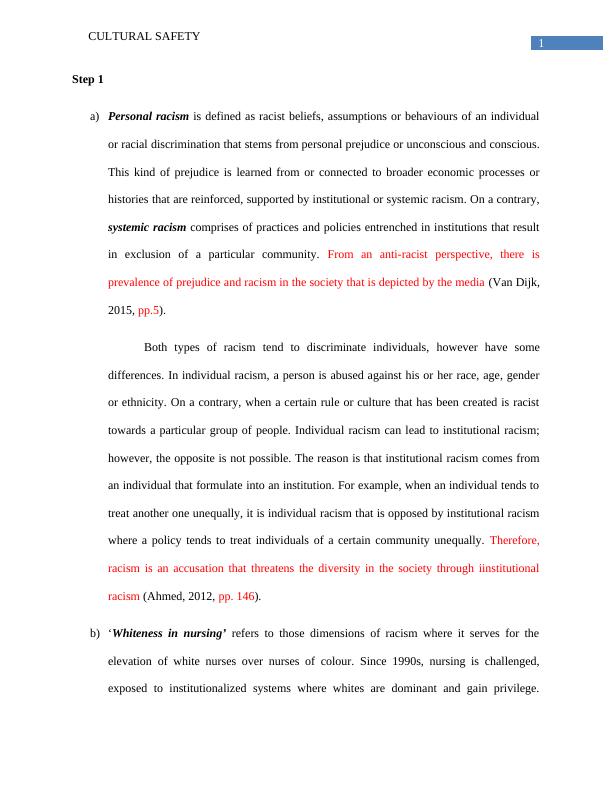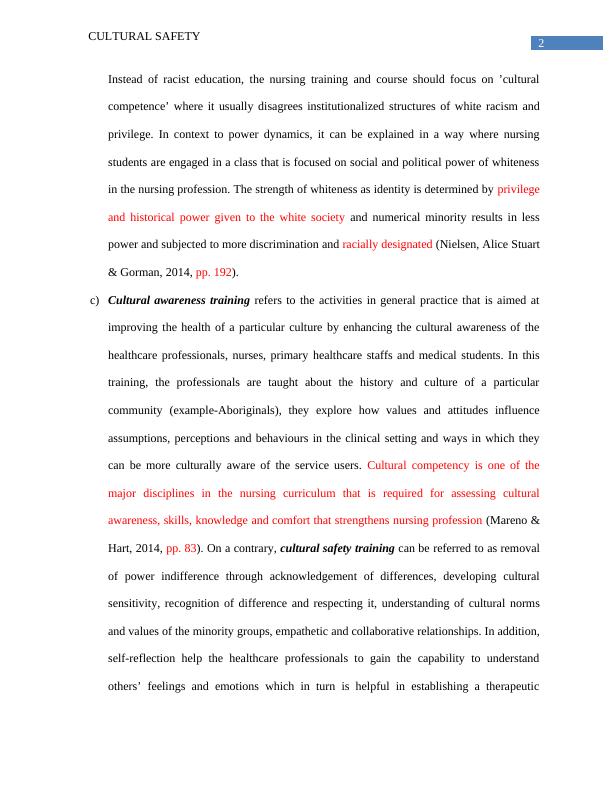Cultural safety assignment
13 Pages3217 Words66 Views
Added on 2021-04-21
Cultural safety assignment
Added on 2021-04-21
ShareRelated Documents
Running head: CULTURAL SAFETY Cultural safetyName of the StudentName of the UniversityAuthor note

1CULTURAL SAFETY Step 1 a)Personal racism is defined as racist beliefs, assumptions or behaviours of an individualor racial discrimination that stems from personal prejudice or unconscious and conscious.This kind of prejudice is learned from or connected to broader economic processes orhistories that are reinforced, supported by institutional or systemic racism. On a contrary,systemic racism comprises of practices and policies entrenched in institutions that resultin exclusion of a particular community. From an anti-racist perspective, there isprevalence of prejudice and racism in the society that is depicted by the media (Van Dijk,2015, pp.5). Both types of racism tend to discriminate individuals, however have somedifferences. In individual racism, a person is abused against his or her race, age, genderor ethnicity. On a contrary, when a certain rule or culture that has been created is racisttowards a particular group of people. Individual racism can lead to institutional racism;however, the opposite is not possible. The reason is that institutional racism comes froman individual that formulate into an institution. For example, when an individual tends totreat another one unequally, it is individual racism that is opposed by institutional racismwhere a policy tends to treat individuals of a certain community unequally. Therefore,racism is an accusation that threatens the diversity in the society through iinstitutionalracism (Ahmed, 2012, pp. 146). b)‘Whiteness in nursing’ refers to those dimensions of racism where it serves for theelevation of white nurses over nurses of colour. Since 1990s, nursing is challenged,exposed to institutionalized systems where whites are dominant and gain privilege.

2CULTURAL SAFETY Instead of racist education, the nursing training and course should focus on ’culturalcompetence’ where it usually disagrees institutionalized structures of white racism andprivilege. In context to power dynamics, it can be explained in a way where nursingstudents are engaged in a class that is focused on social and political power of whitenessin the nursing profession. The strength of whiteness as identity is determined by privilegeand historical power given to the white society and numerical minority results in lesspower and subjected to more discrimination and racially designated (Nielsen, Alice Stuart& Gorman, 2014, pp. 192).c)Cultural awareness training refers to the activities in general practice that is aimed atimproving the health of a particular culture by enhancing the cultural awareness of thehealthcare professionals, nurses, primary healthcare staffs and medical students. In thistraining, the professionals are taught about the history and culture of a particularcommunity (example-Aboriginals), they explore how values and attitudes influenceassumptions, perceptions and behaviours in the clinical setting and ways in which theycan be more culturally aware of the service users. Cultural competency is one of themajor disciplines in the nursing curriculum that is required for assessing culturalawareness, skills, knowledge and comfort that strengthens nursing profession (Mareno &Hart, 2014, pp. 83). On a contrary, cultural safety training can be referred to as removalof power indifference through acknowledgement of differences, developing culturalsensitivity, recognition of difference and respecting it, understanding of cultural normsand values of the minority groups, empathetic and collaborative relationships. In addition,self-reflection help the healthcare professionals to gain the capability to understandothers’ feelings and emotions which in turn is helpful in establishing a therapeutic

3CULTURAL SAFETY relationship with clients that lead to better health outcomes. Cultural safety alsoincorporates social justice and advocacy on behalf of minority communities. Nursingprofession is an art as well as science that have the primary responsibility to provideeffective, comprehensive, holistic and culturally appropriate caring towards the patientsunder their provision of care (Montenery et al. 2013, pp. e52). Step 2 During my clinical placement, an Aboriginal patient was admitted to the ward followinga suicidal attempt. I was assigned to interact with the patient to know about his problems. At firstinstance, I was very nervous and unable to initiate the conversation. He was unable to explain hisfeelings due to limited English proficiency. As I never interacted with any patient from ethnicbackground, I hesitated to ask him any sort of questions. In this situation, I realized that I shoulddevelop cultural awareness and sensitivity towards clients from other ethnic backgrounds. Step 3 Three key factors explore concepts of Aboriginals wellbeing in regards to access tohealthcare, employment and education. The impact of European colonization, the influence ofcultural and geographical dimensions on individuals and their communities and historicalbarriers are the factors that given clear picture of their physical and mental health status. Afterthe European colonization, the population declined and in 1920s, there were only 60,000Aboriginals had reaching effects. They were forced to move off their traditional lands and awayfrom active hunter-gatherer lifestyle. Many of them were unable to resist this seizure of landsthat resulted in violence. Majority of them died from infectious diseases that were brought byEuropeans. After this shift, they moved to lands where they were unable to speak their native

End of preview
Want to access all the pages? Upload your documents or become a member.
Related Documents
Aboriginal and Torres Strait Islanders’ Wellbeinglg...
|10
|2766
|395
Understanding Cultural Safety in Nursing Practicelg...
|11
|2909
|35
Aboriginal & Torres Strait Islander Peoples’ Wellbeinglg...
|10
|2498
|206
Understanding Different Types of Racism and the Importance of Cultural Safety in Healthcarelg...
|11
|3385
|120
Comparison between personal racism and systematic racismlg...
|12
|3044
|202
Wellbeing of Aboriginal Peoplelg...
|9
|2601
|497
